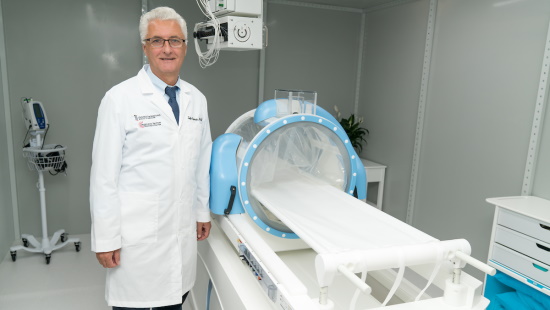Stereotactic Radiosurgery
Stereotactic radiosurgery (SRS) is when doctors direct high doses of radiation to small tumors or other abnormal areas in the brain.
University of Maryland radiation oncologists have been using SRS since 1992. Decades of use have proven SRS safe and effective with minimal side effects.
Stereotactic radiosurgery is not surgery because it doesn’t involve an incision or involve an invasive procedure. However, SRS is often used in place of neurosurgery because it can dramatically shrink both malignant and benign brain tumors and effectively treat other non-cancerous conditions in the brain.
The University of Maryland Department of Radiation Oncology works together with neurosurgeons from UMGCCC’s Brain Tumor Treatment and Research Center to identify which patients will benefit from SRS and how it will fit in with their overall treatment plan. This team meets weekly so patients can receive immediate evaluations.
When UMGCCC Uses SRS
SRS can be used for tumors deemed inoperable because of their location or for patients whose medical conditions put them at high risk for conventional surgery. It is the preferred treatment for patients with metastatic brain tumors.
For primary brain tumors, sometimes SRS is used alone or after surgery to hinder cancer from returning.
Other times, SRS is used after whole brain radiation therapy (WBRT), in which the entire brain receives radiation. However, unlike WBRT, stereotactic radiosurgery focuses radiation on only one or a few precise areas.
SRS can also be used to help patients who have tumors that recur after their previous surgical or radiation treatments and for patients with tumors that were not completely removed by surgery.
Different SRS Techniques
Depending on a patient’s needs, the University of Maryland Medical Center offers both frame-based and frameless SRS. With a frame-based approach, a stereotactic frame is placed around a patient’s head to immobilize it during treatment. Some patients have conditions that make this kind of SRS the ideal approach.
The 2017 addition of the Varian Edge linear accelerator means that frameless stereotactic radiosurgery is now also available at UMMC.
A frame is not needed because an optical surface monitoring system helps to ensure that the patient is correctly placed for treatment. Should the patient move as little as less than a millimeter in any direction during treatment, the radiation beam can be stopped until the patient is back in the correct position.
Conditions Treated with SRS
- Acoustic neuromas
- Arteriovenous malformations (AVM)
- Craniopharyngiomas
- Gliomas
- Meningiomas
- Metastatic tumors
- Pineal region tumors
- Pituitary adenomas
- Skull base tumors
- Trigeminal neuralgia
SRS Physician Team
- William F. Regine, MD
- Howard M. Eisenberg, MD
- Mark Mishra, MD
- Jason Molitoris, MD, PhD
- J. Marc Simard, MD, PhD
- Graeme Woodworth, MD

